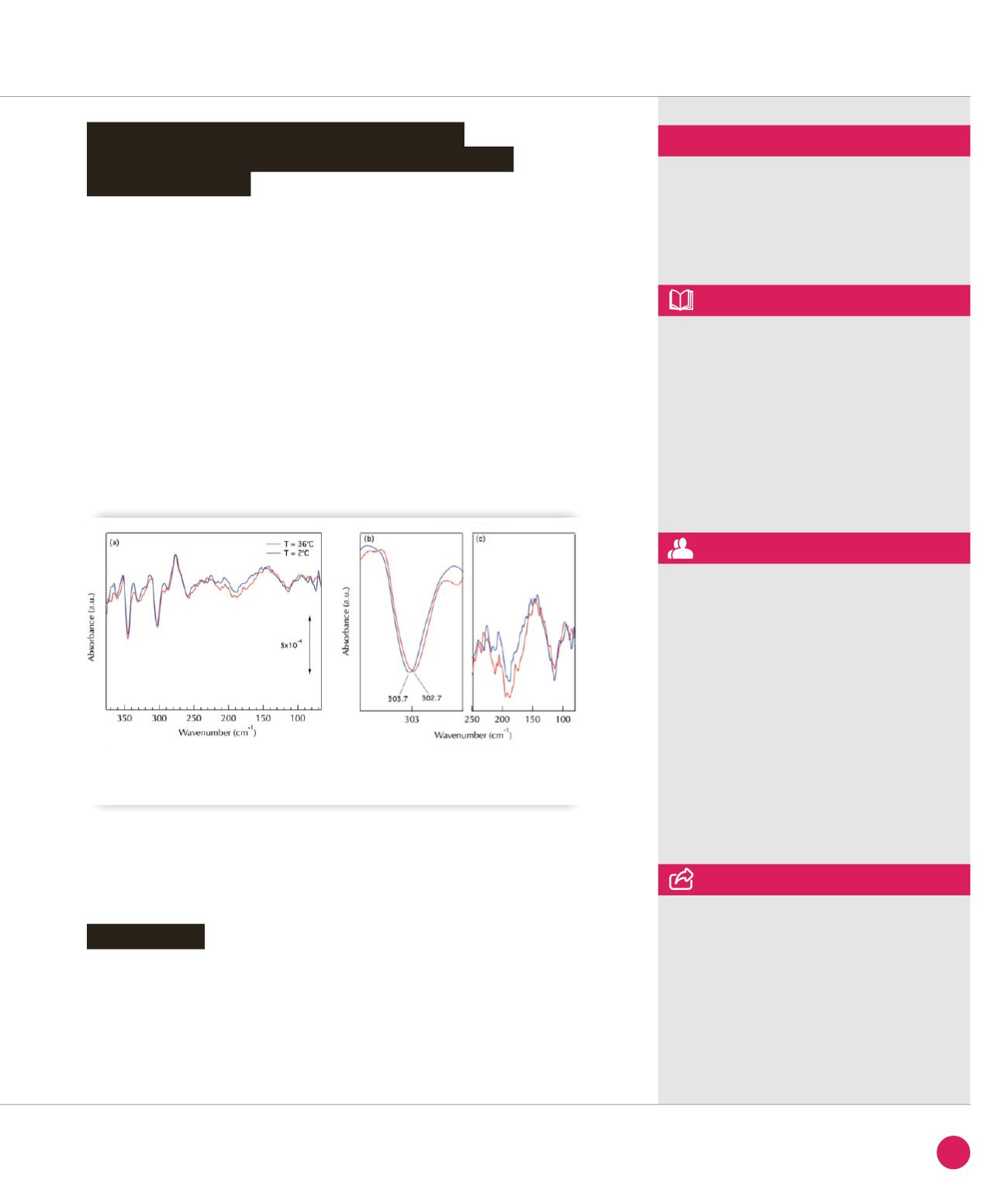
The high resolution spectra obtained using
synchrotron sources has allowed the first
identification of metal-ligand IR modes
using shifts induced by metal labelling, a
strategy that overcomes metal substitution
studies as it does not change the metal
centre properties. Moreover, the Far-IR
data provide the first vibrational data on
reduced CuI-azurin. Finally, coupling Far-IR
difference spectroscopy with temperature
changes allows detecting hydrogen
bonding directly relevant to the protein
function.
Hydrogen bonds in proteins, and notably
those involving the wate r solvent,
are highly temperature sensitive.
Therefore, the thermal dependence
of Far-IR absorption of Cu-azurin allows
to specifically probe modes affected
by hydrogen bonding.
Figure
➋
shows a superimposition of
reduced-minus-oxidized difference spectra
recorded at 2°C and 36°C with Cu-azurin
in H
2
O. Temperature increase results in
greater amplitude of the negative broad
band at 225-150 cm
-1
and in a downshift
of the 303.7 cm
-1
band to 302.7 cm
-1
.
The band frequency at 225-150 cm
-1
corresponds to intermolecular H bond
stretching, arising from the longitudinal
motion of the hydrogen atom along the
hydrogen bond axis. The band at 303
cm
-1
contains significant contribution
from
ν
(Cu-(NHis)
2
) vibration. Interestingly,
the histidine Cu ligand His
117
is hydrogen
bonded to a water solvent molecule in
the crystallographic structure of Cu-azurin
(Figure
➋
inset). A weakening of this
hydrogen bond at 36 °C may explain the
temperature dependence of the 303 cm
-1
band frequency. The frequency downshift
observed upon temperature increase
is in line with a decreased electronegativity
of the imidazole ligand due to a weakening
of the imidazole NH °°° OH
2
intermolecular
bond.
Conclusions
Probing hydrogen-bonding by the detection
of temperature sensitive signatures in the Far-IR
difference spectra
AILES beamline
ASSOCIATED PUBLICATION
Electrochemically-induced Far-Infrared
difference spectroscopy on metalloproteins
using advanced synchrotron technology
N. Vita, J-B. Brubach*, R. Hienerwadel,
N. Bremond, D. Berthomieu, P. Roy
and C. Berthomieu
Analytical Chemistry, 85 (2013), 2891
REFERENCES
[1] Brubach, J. B et al. J Chem Phys
122 (2005), 184509
[2] Roy, P. et al. Infrared Physics & Technology
49 (2006), 139
[3] Marboutin, L. et al. J Phys Chem B
113 (2009), 4492
[4] Marboutin, L. et al. Angew Chem Int Ed
50 (2011), 8062
* Synchrotron SOLEIL, l’Orme des Merisiers,
St Aubin BP48, 91192 Gif sur Yvette Cedex,
France
CORRESPONDING AUTHOR
➋
Temperature dependence of the FTIR difference spectra. Superimposition of reduced-minus-oxidized FTIR
difference spectra recorded at 36 °C (red) and 2 °C (blue) on Cu-azurin samples. The main temperature effects
are zoomed in (
b
) and (
c
).
35
SYNCHROTRON
HIGHLIGHTS
2013


